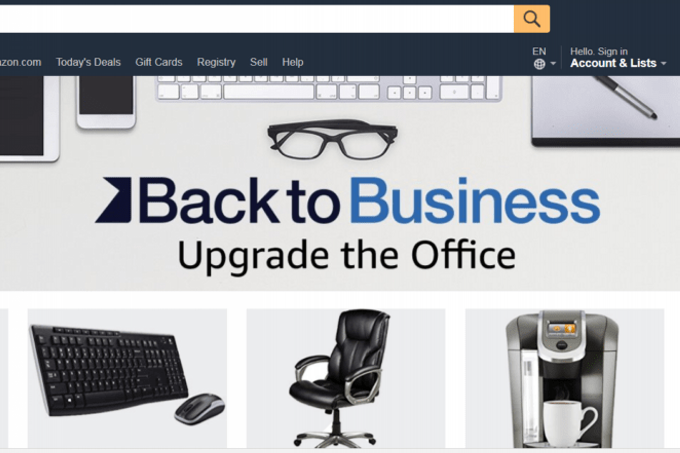
To compete with Amazon Enterprise, massive distributors ought to deal with turning into the dominant market inside a vertical-specific market, somewhat than competing head-to-head with Amazon Enterprise as a multi-category market, says a report from enterprise consultancy Applico Inc.
There may be room for one to 2 specialised marketplaces in every vertical market to turn out to be the dominant or second-largest participant.
Amazon Enterprise has a bonus in competing towards multi-category marketplaces as a result of it serves as an aggregator for big however fragmented markets with commodity merchandise which might be straightforward to pack and ship, similar to industrial and upkeep, restore and operations (MRO) provides, Applico says within the report, “Amazon Enterprise: Menace and alternative in B2B Distribution.”
Nick Johnson, principal, Applico Inc.
This technique permits Amazon Enterprise to shortly scale its catalog by way of third-party sellers, placing competing marketplaces at an obstacle in relation to matching its choice. Amazon Enterprise lists greater than 56 million merchandise, or about 10 occasions as many merchandise as listed by conventional distributors that it competes towards, the report says.
Specialised vertical marketplaces give B2B distributors a combating probability to compete with Amazon Enterprise, as they will supply a wide array of merchandise inside an business vertical, pricing transparency, decrease costs, and a centralized buying and selling portal. These are all attributes B2B consumers discover engaging, says Nick Johnson, a principal for Applico and co-author of the report.
“There may be room for one to 2 specialised marketplaces in every vertical market to turn out to be the dominant or second-largest participant by servicing consumers in methods Amazon Enterprise can’t,” Johnson says.
Utilizing buyer information to develop gross sales
As well as, distributors can develop market gross sales by leveraging current buyer information and arming gross sales representatives with digital gross sales instruments to service consumers that usually buy offline.
“Vertical marketplaces can present customers extra personalized experiences, whereas Amazon Enterprise makes use of an aggregator mannequin that depends on scale and commoditization,” says Johnson. “It’s a unique means of competing with Amazon Enterprise.”
Whereas specialised marketplaces may be potent opponents to Amazon Enterprise, they should act quick as a result of their window of alternative is closing quick, the report says.
Certainly, Amazon Enterprise is making speedy in-roads to a number of B2B market segments, together with meals service and gear, medical and dental, and lab and scientific provides. Since 2017, when Applico launched its Market Tracker to comply with the variety of sellers and merchandise in Amazon Enterprise’s catalog, meals service gear has grown to twenty,000 sellers and greater than 3 million merchandise; the medical provides class has 19,500 sellers and a couple of.9 million merchandise; dental provides has 11,700 sellers and 1.2 million listed merchandise; and lab and scientific has 12,400 sellers and 730,000 listed merchandise. The Market Tracker doesn’t file gross sales by way of Amazon Enterprise.
Within the MRO and industrial provide classes, Amazon Enterprise’s two largest, the ecommerce large lists 31.3 million merchandise. As compared, the main conventional or “incumbent” distributor’s ecommerce web site has about 3 million merchandise in these classes, the report says, with out naming that distributor.
Whereas that distributor plans so as to add 10 million merchandise to its ecommerce web site within the subsequent three-to-five years, most certainly by embracing a market mannequin and permitting third-party sellers on its web site, it will not be sufficient to realize a aggressive benefit on Amazon Enterprise, the report says. As an alternative, the distributor would want so as to add tens of millions of merchandise within the subsequent few months to remain aggressive with Amazon Enterprise, the report says.
Increasing into new product classes
“There’s a noticeable distinction in relation to product choice on Amazon Enterprise and opponents have to handle it, particularly with Amazon Enterprise quickly increasing into new product classes,” Johnson says.
Changing into a number one B2B vertical market, he contends, begins with recognizing that constructing a vertical market from scratch to match or exceed Amazon Enterprise’s product choice in that class will take too lengthy. “It could take 5 to seven years to attain the mandatory scale when constructing a market from scratch,” Johnson says.
A quicker path to attaining the size wanted to dominate a vertical market is thru acquisition or partnering with start-ups. “The objective is to seek out start-ups which have splintered from generalist marketplaces, do effectively at what they do, and produce scale to attain crucial mass,” he says.
Attaining crucial mass will even assist marketplaces fend off competitors by the likes of different massive B2B platforms, similar to Alibaba.com, eBay.com and Walmart.com, the report says.
A greater purchaser expertise for small prospects
One other benefit of digital marketplaces is that they permit distributors to enhance the customer expertise for smaller, irregular prospects they usually don’t serve effectively by way of conventional gross sales channels. Distributors providing a web-based market not solely have an opportunity to retain these prospects, however entice opponents’ prospects they have been beforehand unable to serve, the report says.
Different sources of worth that marketplaces can leverage embody provider relationships, the distributor’s model, client information and insights, ample stock, and such value-added companies as logistics, technical assist, credit score choices, and underwriting and collections, the report says.
“Distributors shouldn’t overlook that Amazon Enterprise is including companies many thought they couldn’t, similar to financing, negotiated and custom-pricing, as a way to add worth to its platform,” Johnson says. “If vertical-specific marketplaces wish to compete with the massive guys, they’ve to seek out methods so as to add worth that allows them to turn out to be sole proprietor of the client.”
Peter Lucas is a Highland Park, Illinois-based freelance journalist masking enterprise and expertise.
Join a complimentary subscription to Digital Commerce 360 B2B Information, revealed 4x/week, masking expertise and enterprise traits within the rising B2B ecommerce business. Contact editor Paul Demery at [email protected] and comply with him on Twitter @pdemery.
Comply with us on LinkedIn and be the primary to know when new Digital Commerce 360 B2B Information content material is revealed.
Favourite



















